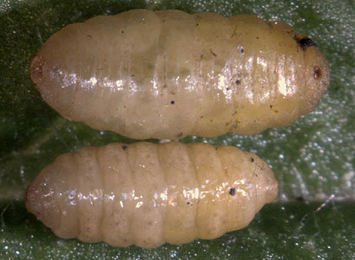|
||||||
|
CICUTA. Cowbane. [Apiaceae] |
|
Only one species of Cicuta, Cowbane (C. virosa), is recorded in Britain. Two British miners are recorded on Cicuta. A key to the European miners recorded on Cicuta is provided in Bladmineerders van Europa. |
|
Key for the identification of the known mines of British |
1a > Leaf-miner: A large blotch, yellow or brown, preceded by a short corridor that in the end mostly is completely overrun. Generally several larvae share a mine. Especially in fresh mines the green primary and secondary feeding lines are well visible. Pupation outside the mine. Hering (1957a) warns that the mines cannot be separated from those of the rare Cryptaciura rotundiventris. Mine is deep and leads to a blotch, which is usually coloured yellow or brown (British leafminers) |
 Euleia heraclei pupariria Image: © Willem Ellis (Bladmineerders van Europa) |
|
Euleia heraclei (Linnaeus, 1758) [Diptera: Tephritidae]. |
1b > Leaf-miner: The larvae are often gregarious and feed on the underside of the leaf causing a 'windowing' effect as they eat the mesophyll and lower epidermis. This effect can be seen from the top of the leaf as it discolours. Short, small, irregular, sometimes widened corridor. Mostly a number in a leaf, concentrated in the axils of the midrib and the primary side veins. Each larva makes a number of mines. Often the larva protrudes with its rear end out of the mine, causing most frass to be ejected. While moving, at the leaf underside, silken threads are produced, in wich grains of frass may be trapped. Older larvae live free and cause window feeding, often in a group under a light spinning. |
|
Epermenia chaerophyllella (Goeze, 1783) [Lepidoptera: Epermeniidae]. |
| Last updated 02-Jul-2019 Brian Pitkin | ||
